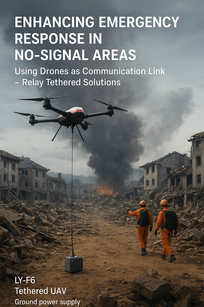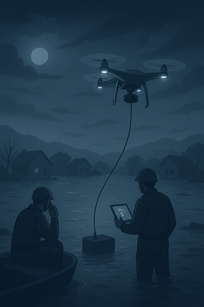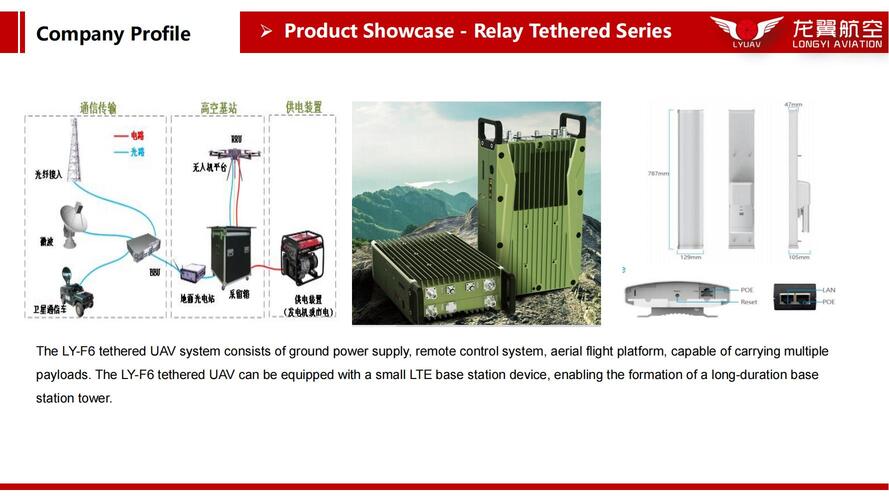Introduction
When disaster strikes in remote or infrastructure-damaged areas, one of the first challenges responders face is the lack of reliable communication signals. Earthquakes, floods, wildfires, or industrial accidents often disrupt mobile networks, making it difficult for rescue teams to coordinate effectively. In such environments, tethered drones have emerged as a critical solution — acting as communication relays to restore connectivity quickly and reliably.
The Challenge of Communication in Remote and Disaster Zones
Rescue operations require seamless communication between ground teams, command centers, and external agencies. However, in many disaster-hit areas, cell towers are damaged or non-existent, leaving responders unable to transmit real-time information.
- No Signal Coverage – Mountainous, forested, or offshore regions often lack telecom infrastructure.
- Damaged Networks – Earthquakes and storms may destroy base stations, cutting off communication.
- Operational Risks – Without communication, rescue efficiency drops, response time increases, and risks to human life grow.

Tethered UAVs as Communication Relays
Unlike conventional drones, tethered UAVs are connected to a ground power supply via a cable, allowing them to fly continuously for hours or even days. Equipped with LTE/5G small base stations or radio repeaters, these drones create a mobile aerial communication tower in the sky.
Key Advantages:
- Extended Flight Time – Continuous operation without battery limitation.
- Stable Power & Data Link – The tether cable provides uninterrupted energy and high-bandwidth connection.
- Elevated Signal Coverage – By hovering at 100–150 meters, the drone extends coverage across wide areas.
- Rapid Deployment – Can be set up within minutes, restoring connectivity faster than rebuilding infrastructure.

Real-World Application Scenario
Imagine a large earthquake hitting a mountainous region. Roads are blocked, power is down, and local communication towers have collapsed. Rescue teams arrive but cannot coordinate due to signal loss.
By deploying a Relay Tethered UAV, responders can:
- Launch the drone and establish a temporary LTE/5G network covering several kilometers.
- Enable rescue teams’ radios, smartphones, and IoT devices to reconnect.
- Provide command centers with live video feeds, GPS tracking, and real-time situational awareness.
- Keep the system running continuously for days, ensuring uninterrupted connectivity until permanent repairs are made.
Features of the LY-F6 Tethered UAV System
The LY-F6 Tethered UAV System exemplifies this solution. It consists of a ground power station, flight platform, and multi-payload support. When equipped with a small LTE base station device, it forms a long-duration aerial relay node.
- Multi-Payload Capacity – Supports LTE/5G modules, communication relays, or surveillance cameras.
- Ground Power Supply – Ensures stable, uninterrupted flight operation.
- Scalable Coverage – Effective for urban, industrial, or rural deployments.
- Operational Flexibility – Ideal for government, military, emergency response, and large-scale events.

The Future of Communication-Enabled Drones
As disasters become more frequent due to climate change and urbanization, the need for mobile, flexible, and reliable communication infrastructure is growing. Tethered drones will play an increasingly vital role in:
- Disaster Relief – Providing instant communication in crisis zones.
- Large Public Events – Offering network support in areas with high user demand.
- Military and Security Operations – Ensuring secure and resilient communication links.
Conclusion
Communication is the backbone of effective rescue missions. When traditional networks fail, tethered drones provide a lifeline — ensuring teams stay connected, coordinated, and capable of saving lives.
At Tai Shun Li Technology Company Ltd., we are committed to delivering industrial-grade tethered UAV solutions like the LY-F6 series, empowering emergency responders to operate with confidence in the toughest environments.